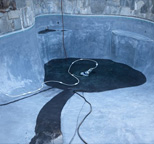
If you’re new to the world of owning pools or just looking to brush up on your pool maintenance schedule, we have all of the information that you need to do so. In the guide below, we’ll explain the maintenance for all types of pools.
Here’s how to maintain your home swimming pool.
How Often Does a Pool Need Maintenance?
A pool needs maintenance at least once a week when it is open. Once the pool is winterized it will no longer need maintenance. Otherwise, it will need you to test and balance the chemicals once per week at least and perform other maintenance on a monthly basis. In addition, maintenance needs can change throughout the year depending on the season.
Weekly Pool Maintenance
It is best if you dedicate some time every week to check up on the pool and perform some basic maintenance. Your first task should be to check the levels of the pool, both its current state and its chemical content. Here are the tests you should run:
- Check the pH levels: In a typical pool, pH levels should be from 7.4 – 7.6, if your pH is higher or lower, your sanitizer may be less effective. When the pH is in the correct range it can be better for your skin and make your water more comfortable.
- Check the chlorine levels: In a typical chlorine pool, your chlorine levels should be somewhere between 1 and 3 ppm. This is optimal to destroy bacteria in the water, without making the water too harsh on you. In a Clear Blue Mineral pool, chlorine levels are typically lower than this. That’s because the minerals and metals in the water work with the chlorine to keep the water safe, so you need less chlorine. Your ideal chlorine levels depend on the sanitizer you’re using. The professionals at Leisure Industries can help you determine where your chlorine should be.
- Shock treatment: Shocking the pool is necessary to remove any oils, organic materials, and bacteria that enter the pool. Most pool owners do this once per week. If your schedule allows, add the shock at night Then, run the pump and filter for at least 8 hours afterward to circulate the chlorine. You may need to do it less often if you have a mineral clear blue pool.
- Algaecide: If you’ve had a problem with algae in your pool, you may need to add a weekly maintenance level of algaecide once per week. However, in a mineral clear blue pool, you may not need to add algaecide.
- Clean: Weekly, you can empty out the skimmer baskets and skim the surface of the pool yourself. Then brush the walls and floor of the pool with brush attachments. Some people do this bi-weekly or even monthly, but it is safer and simpler to do it weekly. Your pool will be more consistently clean and it will be easier to perform the clean-up if you do it weekly.
Pool maintenance is important! To learn more about how to maintain your pool and what products you may need, contact our team at Leisure Industries today.

Fall Pool Maintenance
Does anything change for the fall in terms of pool maintenance? Well, there does tend to be more debris circulating in the fall. Leaves that have dropped from nearby trees always seem to end up in the pool. You may have to up your skimming routine and skim the pool even daily while the bulk of the leaves are falling. Emptying the skimmer baskets regularly is a good idea too. In the fall, your pool’s skimmer will collect more debris, so it may need to be cleaned daily.
Tips for Cleaning Leaves
Leaves can be a hassle in the pool. Here are some ways to make cleaning them up a little easier:
- Use a deep bag skimmer: These larger, wider pool nets make picking up large volumes of leaves much simpler. We suggest our heavy-duty deep leaf net as the best option for pools plagued with lots of leaves.
- Frequently and quickly: If you can spend even a few minutes by your pool cleaning it per day, it will be a much less monumental task. Normally, things get out of control if you leave the leaves in the pool for a week or more.
- Flow pattern: If you can adjust the flow in your pool, try to create a ripple on the surface of your water so that the leaves are always moving. This helps the skimmers pick them up better.
Spring Pool Maintenance
How does pool maintenance change in the spring? The first few weeks after you open your pool will seem like the smoothest weeks. It is fresh from being opened and won’t need much attention. But diligence at this time will set you up for success later. Even if the pool isn’t being used, do your weekly check-ups. And, be sure to check the water’s levels after every rain. Rain will affect your water, and adjusting after each rain will help prevent big problems.
Summer Pool Maintenance
In the summer, your pool will be used more often and will deal with warmer weather. With the hot summer days, now is the time to be extra diligent with your algaecide. Keep in mind after large algae blooms, which usually occur in the summer months, chemically cleaning your filter will help to keep things running smoothly.

Winter Pool Maintenance
You should winterize your pool in the winter. However, before you winterize the pool, you’d benefit from doing some maintenance,
What Happens if You Don’t Winterize Your Pool?
In Canada, if you don’t winterize your pool it may suffer significant damage, including burst pipes, a cracked filter, and more.
Tips for Draining and Covering Pools
Check in with your local government before you drain your pool before winter, as many have rules about when and how you can do so, especially if you have a salt system.
Choose a quality cover and covering your pool will be much less hassle.
What Chemicals to Put in Your Pool for the Winter
Most pools will need several chemicals before winter arrives, including:
- Pool shock
- Winter algaecide
- Stain and scale treatment
The experts at Leisure Industries will be able to walk you through what is best for your pool in the winter.

Pool Circulation
Your pool pump needs to run at least eight hours per day. However, the more you can run the pump, the better, especially on hot summer days. Moving water is less likely to develop problems, from algae to bacteria, and less likely to retain body oils, dust, and other debris.
How to Clean Your Pool Filter
You’ll want to check with your manufacturer’s instructions before you clean your pool filter. If you are lucky to have a sorel filter, a simple backwash is all that is needed. However, the basic steps are as follows for cartridge type filters:
- Turn off the pump and filter.
- Remove the air from the filter.
- Remove the filter’s lid.
- Take out the cartridge and clean it with a filter cleaner.
- Rinse the cartridge and return it to its place.
- Secure the filter.
- Turn the filter back on.
- Open the air relief valve to release air from the filter.
- Check the filter’s pressure to be sure it is still working.
Pool Cleaning Tools
At Leisure Industries, we carry many pool cleaning tools that can help make your cleaning job a little easier. This includes:
- Floor and wall brushes: For manual use, these brushes help you clean off debris from the walls and floor of the pool. You’ll need a handle for them.
- Skimmer nets: You run these nets along the surface of the water to catch debris that is floating on the top of the water. Deep leaf skimmer nets are designed to go to the bottom of the pool to pick up larger leaves.
- Finger brushes: For those little spot treatments, use our finger brush.
- Corner and step vacuum brushes: It can be hard to get into steps and corners with your typical pool vacuum’s brush attachments, but this brush makes it easy.
- Miracle pads: These pads help remove debris without the use of chemicals.
Be cool and clean your pool! Enjoy the warmer weather with a clean pool this season. To learn more about pool maintenance, give our team at Leisure Industries a call today!
Updated 2023.




